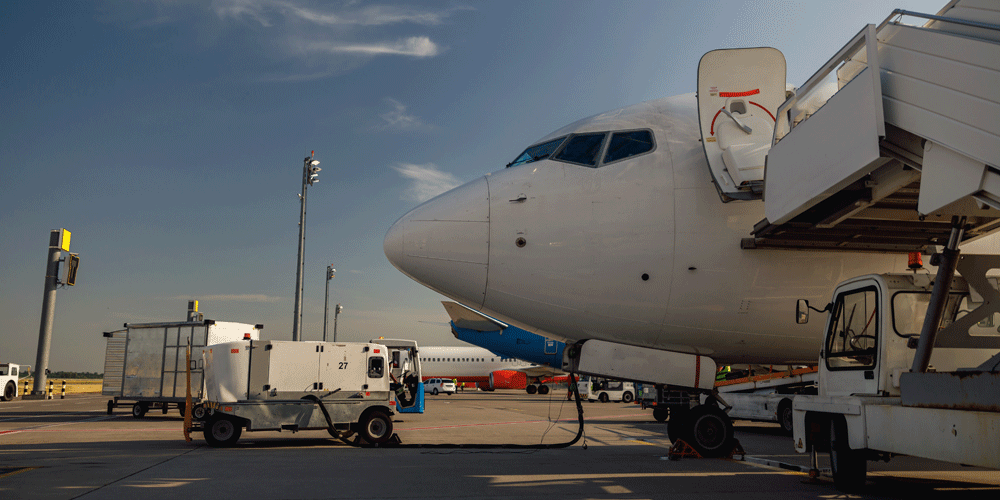Types of Certifications and Security Clearances for Truck Drivers
Having grown up around the trucking industry — with his dad and several uncles serving as truck drivers — it’s only natural Jeron found his way into the industry as well. Jeron joined ATS in 2018 as a member of the marketing team, where he grew his knowledge of the trucking industry substantially. Now as the driver recruiting manager, he is responsible for ensuring a smooth recruiting process in order to create a quality driver experience.
Drivers are always looking for a way to make more money. One of the best ways to do that? Diversify your skillset!
Wondering how to diversify your skillset? Get clearance to haul freight in areas you’ve never been able to access before!
The more you open up your opportunities for the types of freight you can haul and the places you can go, the more money you can make.
Typically, truck drivers don’t require security clearances unless they’re involved in specialized or sensitive transportation operations. For instance, if a truck driver is engaged in a job that involves transporting goods or materials related to national security, classified information or sensitive installations, they may be required to obtain certain security clearances.
However, the more clearances, certifications and endorsements you get, the more opportunities you have. With a Transportation Worker Identification Credential (TWIC card), passport, Transport Security Administration (TSA) certification, government security clearance and Hazmat endorsement, you open yourself up to haul freight in Canada and Mexico, at ports and at airports and on military bases. A lot of this freight is lucrative and can make a huge difference in your wallet.
In this article, you’ll learn about the different clearances, certifications and endorsements you can get to diversify your freight options to haul more and earn more money.
TWIC Card
A TWIC card is an identification card issued by the Transportation Security Administration (TSA) in the U.S. It’s designed to enhance security at maritime facilities and regulate access to certain sensitive areas within the transportation industry.
The TWIC card is required for individuals who need unescorted access to secure areas of maritime facilities or vessels regulated by the Maritime Transportation Security Act (MTSA) of 2002. This includes workers who are involved in maritime transportation, such as longshoremen, port workers, truck drivers, mariners and others who require access to restricted areas.
The TWIC card requires fingerprints and a background check to ensure individuals who hold the card have been vetted for security purposes. It serves as a form of identification and allows authorized personnel to gain access to restricted areas, such as ports, terminals and other maritime facilities.
Without a TWIC card, you can’t access these authorized locations without an escort. You may have to pay a fee for an escort and you’ll be at the mercy of their schedule. Keep in mind, some ports don’t allow escorts and you must have a TWIC card to enter.
To obtain a TWIC card, which is a fairly easy process, applicants must submit personal information, undergo a security threat assessment, provide fingerprints and pay a fee of $125.25. The card is valid for five years, after which it must be renewed for $60.
It's important to note that the TWIC card is specific to the transportation industry and is different from other security clearances, such as those issued by the Department of Defense (DOD) or other government agencies. It’s also not the same as a TSA certification.
Related: What paperwork do you need to get a TWIC card?
Passport
A passport is a great investment for truck drivers, as it’ll allow you to cross the border into Canada and Mexico to haul lucrative freight. It isn’t the same thing as a TWIC card, as a TWIC card cannot be used to travel internationally — it’s only used to access ports.
If you need to get a passport, you’ll need to complete the following steps:
- Prepare the required documents for a passport application. These typically include proof of U.S. citizenship (such as a birth certificate or previous passport), a valid form of identification (such as a driver's license) and any additional supporting documentation requested by the passport agency.
- Fill out the DS-11 Application. You can complete this form online or print it out and fill it in manually. Be sure to provide accurate and up-to-date information.
- Get passport photos taken that meet the specifications outlined by the U.S. Department of State. Many drugstores, photo studios or post offices offer passport photo services.
- Locate a passport acceptance facility near you. These can include post offices, government offices and some public libraries. Bring your completed application form, necessary documents, photos and any applicable fees. The acceptance facility will review your documents, administer an oath and accept your application.
- Pay the passport application fees, which consist of an application fee and an execution fee. The fees vary depending on factors such as the type of passport, whether it's a new application or renewal and processing options. Check out the current fee schedule.
- If you need your passport expedited due to imminent travel plans, you may be required to provide proof of your travel itinerary or an expedited service fee.
After submitting your application, it typically takes several weeks for the passport to be processed. You can track the status of your application online using the application's reference number. Once your application is processed, your passport will be mailed to you at the address you provided on the application form.
After receiving your passport, some drivers elect to enroll in the Free and Secure Trade (FAST) program for commercial vehicles. The clearance program allows low-risk drivers with low-risk shipments to go through customs much faster and use special lanes at busy border crossings.
TSA
TSA-certified drivers can access TSA-controlled airports and facilities. The certification allows drivers to enter TSA areas and move freight from their trucks to an aircraft. This certification isn’t needed for drivers picking up already-cleared freight from an airport.
Air travel is heavily regulated, as is the freight that can travel by air. The TSA certification adds another level of safety.
It can be a bit confusing to understand how to get this certification, but there are only two steps.
First, you must work for a trucking company that has completed the steps to become a certified Indirect Air Carrier (IAC). This certification is earned annually and is done so by submitting an application through the TSA’s Indirect Air Carrier Management System. Carriers also have to work with a TSA Principle Security Inspector.
If the trucking company you drive for is a certified IAC, you’ll need to go through the Security Threat Assessment (STA) to receive unescorted access to cargo shipped by air. Drivers also need training on handling sensitive information and cargo.
The TSA ensures you’re not a threat to national security or transportation security and you’re not a suspected terrorist.
Once you submit the STA application, the TSA needs to confirm your identity and information. Once confirmed, you’ll receive the TSA certification.
Related: Learn more about why the TSA certification benefits you
Government Security Clearance
To haul transport protective service (TPS) freight and arms, ammunition and explosives (AA&E), drivers need to fill out the Standard Form 86 (SF-86). This is a comprehensive questionnaire used to conduct a background investigation for individuals seeking a security clearance in the U.S.
The SF-86 collects detailed information about an individual’s personal, educational, employment and financial history. It includes sections that ask for information on residences, employment history, education, references, foreign contacts, military service, criminal record, drug usage, financial history and more.
While the SF-86 is not directly related to truck driving, certain truck drivers may need to complete the form if their job involves handling sensitive or classified materials, transporting goods related to national security or working in positions that require a security clearance.
The requirement for a truck driver to complete the SF-86 form would depend on the specific job responsibilities and the security protocols set by the employer or the government agency they work for. Truck drivers in such roles may be required to undergo a background investigation as part of the security clearance process, and the SF-86 would be one of the forms they need to complete to initiate that investigation.
For instance, if a driver wanted to haul freight for the Department of Defense (DOD) with their trucking company, filling out the SF-86 and receiving security clearance would grant them access to that (very lucrative) freight.
Related: What does it take to haul military freight for the DOD?
Hazardous Materials Endorsement
While a hazardous materials endorsement (H endorsement) doesn’t allow you access to special locations, it’s required to move a lot of the freight mentioned above — specifically DOD freight for the military.
To obtain a Hazmat endorsement on a commercial driver’s license (CDL) in the U.S., drivers must follow a specific process mandated by the TSA and the Federal Motor Carrier Safety Administration (FMCSA). After ensuring you’re eligible to apply, here are the general steps involved in obtaining a Hazmat endorsement:
- Visit your local Department of Motor Vehicles (DMV) or licensing agency and request a Hazmat endorsement application. Fill out the application form accurately and completely.
- Schedule an appointment with a TSA-approved fingerprinting location to complete the required background check. The TSA will conduct a security threat assessment to determine your eligibility for the Hazmat endorsement. The fingerprinting fee is typically separate from the application fee.
- Prepare the necessary documents for your application, which may include your CDL, proof of citizenship or immigration status, Social Security number, and any other documents required by your state's licensing agency. Check with your local DMV for specific document requirements.
- Study the Hazardous Materials section of the CDL manual and prepare for the Hazmat knowledge test.
- Pay the required application and endorsement fees at the DMV or licensing agency. The fees may vary depending on your state.
The TSA will review your background check results and application. If you pass the security threat assessment and meet all the requirements (including passing the knowledge test), the TSA will notify your state’s licensing agency of your eligibility for the Hazmat endorsement.
Once the TSA approves your application, visit the DMV or licensing agency again to receive your new CDL with the Hazmat endorsement. You may need to have a new photo taken and surrender your old CDL.
It's important to note that the process and requirements for obtaining a Hazmat endorsement can vary slightly between states. Check with your local DMV or licensing agency for specific guidelines and procedures in your state.
Related: CDL endorsements

Haul More Freight
Diversifying your skillset as a truck driver can greatly enhance your earning potential. Obtaining various certifications and security clearances can open up new opportunities for hauling freight and accessing restricted areas. There are five important credentials: the TWIC card, passport, TSA certification, and government security clearance, as well as the Hazmat endorsement. Each of these certifications grants drivers like you access to specific areas, such as ports, airports, military bases and international borders, enabling you to transport a wider range of freight and earn higher incomes.
By obtaining these certifications and clearances, you can significantly increase your earning potential and access more diverse and profitable freight options. However, it’s important to note that the specific requirements and processes for obtaining these credentials may vary. It’s advisable to consult local authorities and agencies for accurate and up-to-date information.
Overall, investing in expanding your skillset is a valuable strategy for truck drivers — especially when the market takes a turn.
For more tips to enhance your opportunities and financial success, check out these tips for hauling freight in a soft market.



